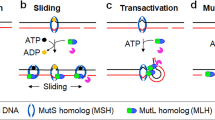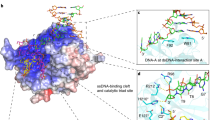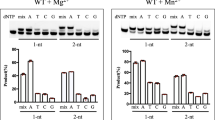Abstract
Cells have evolved sophisticated DNA repair systems to correct damaged DNA. However, the human DNA mismatch repair protein Msh2–Msh3 is involved in the process of trinucleotide (CNG) DNA expansion rather than repair. Using purified protein and synthetic DNA substrates, we show that Msh2–Msh3 binds to CAG-hairpin DNA, a prime candidate for an expansion intermediate. CAG-hairpin binding inhibits the ATPase activity of Msh2–Msh3 and alters both nucleotide (ADP and ATP) affinity and binding interfaces between protein and DNA. These changes in Msh2–Msh3 function depend on the presence of A·A mispaired bases in the stem of the hairpin and on the hairpin DNA structure per se. These studies identify critical functional defects in the Msh2–Msh3–CAG hairpin complex that could misdirect the DNA repair process.
This is a preview of subscription content, access via your institution
Access options
Subscribe to this journal
Receive 12 print issues and online access
$189.00 per year
only $15.75 per issue
Buy this article
- Purchase on Springer Link
- Instant access to full article PDF
Prices may be subject to local taxes which are calculated during checkout









Similar content being viewed by others
Accession codes
References
Alani, E. The Saccharomyces cerevisiae Msh2 and Msh6 proteins form a complex that specifically binds to duplex oligonucleotides containing mismatched DNA base pairs. Mol. Cell. Biol. 16, 5604–5615 (1996).
Acharya, S. et al. hMSH2 forms specific mispair-binding complexes with hMsh3 and hMsh6. Proc. Natl. Acad. Sci. USA 93, 13629–13634 (1996).
Blackwell, L.J., Bjornson, K.P. & Modrich, P. DNA dependent activation of the hMutSalpha ATPase. J. Biol. Chem. 273, 32049–32054 (1998).
Modrich, P. & LaHue, R.S. Mismatch repair in replication fidelity, genetic recombination and cancer biology. Annu. Rev. Biochem. 65, 101–113 (1996).
Genschel, J., Littman, S.J., Drummond, J.T. & Modrich, P. Isolation of MutSβ from human cells and comparison of the mismatch repair specificities of MutSβ and Mutsα. J. Biol. Chem. 273, 19895–19901 (1998).
Johnson, R.E., Kovvali, G.K., Prakash, L. & Prakash, S. Requirement of the yeast Msh3 and Msh6 genes for Msh2-dependent genomic stability. J. Biol. Chem. 271, 7285–7288 (1996).
Marsischky, G.T., Filosi, N., Kane, M.F. & Kolodner, R.D. Redundancy of Saccharomyces cerevisiae MSH3 and MSH6 in MSH2-dependent mismatch repair. Genes Dev. 10, 407–420 (1996).
Palombo, F. et al. hMurSbeta, a heterodimer of hMSH2 and hMSH3, binds to insertion/deletion loops in DNA. Curr. Biol. 6, 1181–1184 (1996).
Gradia, S. et al. hMSH2–hMSH6 forms a hydrolysis-independent sliding clamp on mismatched DNA. Mol. Cell 3, 255–261 (1999).
Wilson, T., Guerrette, S. & Fishel, R. Dissociation of mismatch recognition and ATPase activity by hMSH2–MSH3. J. Biol. Chem. 274, 21659–21664 (1999).
Allen, D.J. et al. MutS mediates heteroduplex loop formation by a translocation mechanism. EMBO J. 16, 4467–4476 (1997).
Blackwell, L.J., Bjornson, K.P., Allen, D.J. & Modrich, P. Distinct MutS DNA-binding modes that are differentially modulated by ATP binding and hydrolysis. J. Biol. Chem. 276, 34339–34347 (2001).
Gradia, S., Acharya, S. & Fishel, R. The role of mismatched oligonucleotides in activating the hMSH2–MSH6 molecular switch. J. Biol. Chem. 275, 3922–3930 (2000).
Martik, D., Baitinger, C. & Modrich, P. Differential specificities and simultaneous occupancy of human MutSα nucleotide binding. J. Biol. Chem. 279, 28402–28410 (2004).
van den Broek, W.J. et al. Somatic expansion behavior of the (CTG)n repeat in myotonic dystrophy knock-in mice is differentially affected by Msh3 and Msh6 mismatch-repair proteins. Hum. Mol. Genet. 11, 191–199 (2002).
Dufner, P., Marra, G., Raschle, M. & Jiricny, J. Mismatch recognition and DNA-dependent stimulation of the ATPase activity of hMutSα is abolished by a single mutation in the hMSH6 subunit. J. Biol. Chem. 275, 36550–36555 (2000).
Junop, M.S., Obmolova, G., Rausch, K., Hsieh, P. & Yang, W. Composite active site of an ABC ATPase: MutS uses ATP to verify mismatch recognition and authorize DNA repair. Mol. Cell 7, 1–12 (2001).
Drotschmann, K., Yang, W. & Kunkel, T.A. Evidence for sequential action of two ATPase active sites in yeast MSH2–MSH6. DNA Repair (Amst.) 1, 743–753 (2002).
Lamers, M.H., Winterwerp, H.H. & Sixma, T.K. The alternating ATPase domains of MutS control DNA mismatch repair. EMBO J. 22, 746–756 (2003).
Baitinger, C., Burdett, V. & Modrich, P. Hydrolytically deficient MutS E694A is defective in the MutL-dependent activation of MutH and in the mismatch-dependent assembly of the MutS.MutL.heteroduplex complex. J. Biol. Chem. 278, 49505–49511 (2003).
Selmane, T., Schofield, M.J., Nayak, S., Du, C. & Hsieh, P. Formation of a DNA mismatch repair complex mediated by ATP. J. Mol. Biol. 334, 949–965 (2003).
Bjornson, K.P. & Modrich, P. Differential and simultaneous adenosine di- and triphosphate binding by MutS. J. Biol. Chem. 278, 18557–18562 (2003).
Cummings, C.J. & Zoghbi, H.Y. Fourteen and counting; unraveling trinucleotide repeat diseases. Hum. Mol. Genet. 9, 909–916 (2000).
Lahue, R.S. & Slater, D.L. DNA repair and trinucleotide repeat instability. Front. Biosci. 8, s653–s666 (2003).
McMurray, C.T. DNA secondary structure: A common and causative factor for expansion in human disease. Proc. Natl. Acad. Sci. USA 96, 1823–1825 (1999).
Manley, K., Shirley, T.L., Flaherty, L. & Messer, A. MSH2 deficiency prevents in vivo somatic instability of the CAG repeat in Huntington disease transgenic mice. Nat. Genet. 23, 471–473 (1999).
Kovtun, I.V. & McMurray, C.T. Trinucleotide expansion in haploid germ cells by gap repair. Nat. Genet. 27, 407–411 (2001).
Seznec, H. et al. Transgenic mice carrying large human genomic sequences with expanded CTG repeat mimic closely the DM CTG repeat intergenerational and somatic instability. Hum. Mol. Genet. 9, 1185–1194 (2000).
Iyer, R.R. & Wells, R.D. Expansion and deletion of triplet repeat sequences in Escherichia coli occur on the leading strand of DNA replication. J. Biol. Chem. 274, 3865–3877 (1999).
Kang, S., Jaworski, A., Ohshima, K. & Wells, R.D. Expansion and deletion of CTG repeats from human disease genes are determined by the direction of replication in E. coli. Nat. Genet. 10, 213–218 (1995).
Miret, J.J., Pessoa-Brandao, L. & Lahue, R.S. Orientation-dependent and sequence-specific expansion of CTG/CAG trinucleotide repeats in Saccharomyces cerevisiae. Proc. Natl. Acad. Sci. USA 95, 12438–12443 (1998).
Gacy, A.M., Goellner, G., Juranic, N., Macura, S. & McMurray, C.T. Trinucleotide repeats that expand in human disease form hairpin structures in vitro. Cell 81, 533–540 (1995).
Freudenreich, C.H., Kantrow, S.M. & Zakian, V.A. Expansion and length- dependent fragility of CTG repeats in yeast. Science 279, 853–856 (1998).
Fortune, M.T., Vassilopoulos, C., Coolbaugh, M.I., Siciliano, M.J. & Monckton, D.G. Dramatic, expansion-biased, age-dependent, tissue-specific somatic mosaicism in a transgenic mouse model of triplet instability. Hum. Mol. Genet. 9, 439–445 (2000).
Chong, S.S. et al. Contribution of DNA sequence and CAG size to mutation frequencies of intermediate alleles for Huntington disease: evidence from single sperm analysis. Hum. Mol. Genet. 6, 301–309 (1997).
Freudenreich, C.H., Stavenhagen, J.B. & Zakian, V.A. Stability of a CTG/CAG trinucleotide repeat in yeast is dependent on its orientation in the genome. Mol. Cell. Biol. 17, 2090–2097 (1997).
Miret, J.J., Pessoa-Brandão, L. & Lahue, R.S. Instability of CAG and CTG trinucleotide repeats in Saccharomyces cerevesiae. Mol. Cell. Biol. 17, 3382–3387 (1997).
Moore, H., Greewell, P.W., Liu, C.-P., Arnheim, N. & Petes, T.D. Triplet repeats form secondary structures that escape DNA repair in yeast. Proc. Natl. Acad. Sci. USA 96, 1504–1509 (1999).
Pearson, C.E., Ewel, A., Acharya, S., Fishel, R.A. & Sinden, R.R. Human MSH2 binds to trinucleotide repeat DNA structures associated with neurodegenerative diseases. Hum. Mol. Genet. 6, 1117–1123 (1997).
Gacy, A.M. & McMurray, C.T. Influence of hairpins on template reannealing at trinucleotide repeat duplexes: a model for slipped DNA. Biochemistry 37, 9426–9434 (1998).
Acharya, S., Foster, P.L., Brooks, P. & Fishel, R. The coordinated functions of the E. coli MutS and MutL proteins in mismatch repair. Mol. Cell 12, 233–246 (2003).
Dzantiev, L. et al. A defined human system that supports bidirectional mismatch-provoked excision. Mol. Cell 15, 31–41 (2004).
Zuker, M. Mfold web server for nucleic acid folding and hybridization prediction. Nucleic Acids Res. 31, 3406–3415 (2003).
Goellner, G.M. et al. Different mechanisms underlie DNA instability in Huntington disease and colorectal cancer. Am. J. Hum. Genet. 60, 879–890 (1997).
Muller, A. & Fishel, R. Mismatch repair and the hereditary non-polyposis colorectal cancer syndrome (HNPCC). Cancer Invest. 20, 102–109 (2002).
Peltomaki, P. Deficient DNA mismatch repair: a common etiologic factor for colon cancer. Hum. Mol. Genet. 10, 735–740 (2001).
Mangiarini, L. et al. Exon 1 of the HD gene with an expanded CAG repeat is sufficient to cause a progressive neurological phenotype in transgenic mice. Cell 87, 493–506 (1996).
Owen, B.A.L., Sullivan, W.P., Felts, S.J. & Toft, D.O. Regulation of heat shock protein 90 ATPase activity by sequences in the carboxyl terminus. J. Biol. Chem. 277, 7086–7091 (2002).
Acknowledgements
We thank J.P. Carney for discussions and D.O. Toft for critical reading of the manuscript. This work was funded by the US National Institutes of Health. This work was funded by NIH GM-066359 and NINDS-R01NS40738 (C.T.M.); NIH CA-0955690 (T.M.W.); NIH-GM52426 (J.J.H.); and NIH-CA84301 and NIH-ES11040 (R.K.).
Author information
Authors and Affiliations
Corresponding author
Ethics declarations
Competing interests
The authors declare no competing financial interests.
Supplementary information
Supplementary Fig. 1
CAG-hairpin binding changes stoichiometry, not composition, of protein/DNA complexes. (PDF 98 kb)
Rights and permissions
About this article
Cite this article
Owen, B., Yang, Z., Lai, M. et al. (CAG)n-hairpin DNA binds to Msh2–Msh3 and changes properties of mismatch recognition. Nat Struct Mol Biol 12, 663–670 (2005). https://doi.org/10.1038/nsmb965
Received:
Accepted:
Published:
Issue Date:
DOI: https://doi.org/10.1038/nsmb965
This article is cited by
-
Dynamic alternative DNA structures in biology and disease
Nature Reviews Genetics (2023)
-
Distinct DNA repair pathways cause genomic instability at alternative DNA structures
Nature Communications (2020)
-
DNA mismatch repair in trinucleotide repeat instability
Science China Life Sciences (2017)
-
Crosstalk between MSH2–MSH3 and polβ promotes trinucleotide repeat expansion during base excision repair
Nature Communications (2016)
-
MutSβ promotes trinucleotide repeat expansion by recruiting DNA polymerase β to nascent (CAG)n or (CTG)n hairpins for error-prone DNA synthesis
Cell Research (2016)



